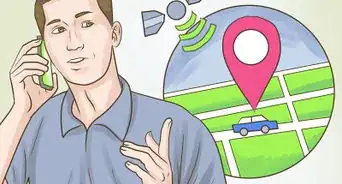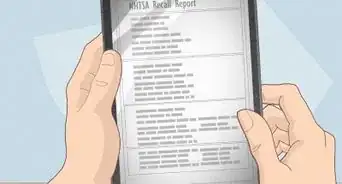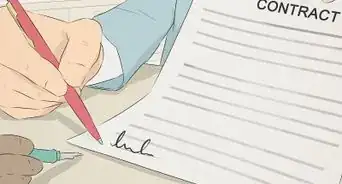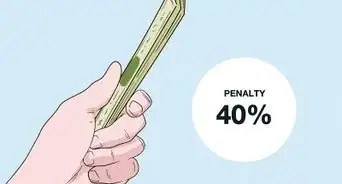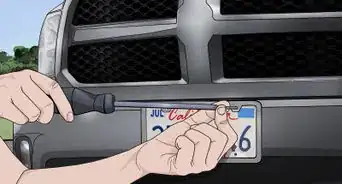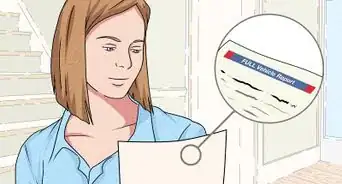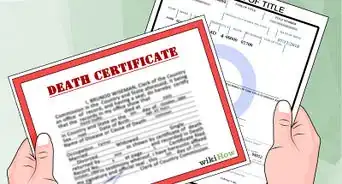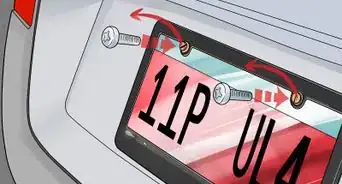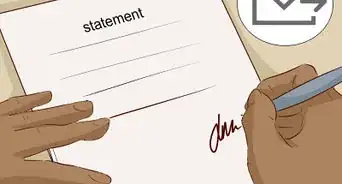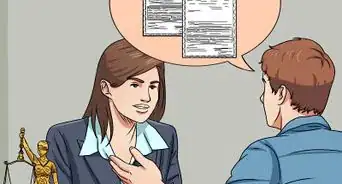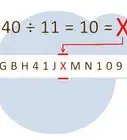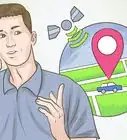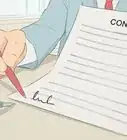This article was co-authored by Audra Fordin. Audra Fordin is a Certified Automotive Technician, the Founder of Women Auto Know, and the Owner of Great Bear Auto Repair in Flushing, New York. With more than 38 years of experience, she has intensive knowledge about foreign and domestic auto repairs. Audra has been featured on numerous news and talk shows such as The Today Show, Inside Edition, and Anderson Cooper.
There are 11 references cited in this article, which can be found at the bottom of the page.
This article has been viewed 348,889 times.
A Vehicle Identification Number (VIN) is like your car’s fingerprint. Every car should have a unique number that can be used to identify it. Check for the VIN at various places on the car. You can also find the VIN on many car documents, such as the title or registration. Because thieves will tamper with the VIN label, you should carefully inspect it before buying a used car.
Things You Should Know
- Check the dashboard, front car frame, spare tire, driver-side door, rear tire well, and engine block for a printed VIN.
- See if the VIN is listed on your car's title, registration, owner's manual, or insurance documents.
- Inspect the Federal Safety Certification Label and VIN plate to see if your VIN seems legit.
- Search your VIN online to see if your car was originally stolen.
Steps
Locating the VIN on the Car
-
1Check the dashboard. Most VIN plates appear on the lower left-hand side of the dashboard.[1] Sit in the driver’s seat and look on the dashboard in front of the steering wheel.[2] Alternately, you might be able to see the VIN easier by standing outside the vehicle and looking through the windshield.
- The VIN should have 17 characters if the car was manufactured after 1981. Vehicles manufactured before that date had VINs from 11 to 17 characters.[3]
- A typical VIN might read 1HGBM22JXMN109186.
-
2Check the front of the car frame. Sometimes, the VIN will appear on the car frame, near the windshield washer container.[4] You should crouch down in front of the car on the driver’s side and check.[5]Advertisement
-
3Pick up the spare tire. The VIN sometimes appears underneath the spare tire, which is usually in the trunk.[6] Pick up the tire to check.
-
4Check the driver-side door. The VIN should also appear on the Federal Safety Certification Label which is in all new cars. This label should appear on the driver’s side door in the following places:[7]
- On the driver-side doorpost. With the door open, check the spot where the door latches. It should be near the seatbelt return.
- Inside the driver-side doorjamb. Open the door and look straight ahead. The VIN should be inside the doorjamb, where the mirror is located when the door is shut.[8]
-
5Peek in the rear wheel well. Crouch down beside the car, near the rear wheel on the driver’s side. Look up into the well, above the tire. The VIN might be located there, inside the wheel well.[9]
-
6Call the dealership or manufacturer. Call if you’ve looked everywhere but couldn’t find the VIN.[10] Give them the make and model of your car and ask where the VIN is located. They should be able to help.
-
7
Finding the VIN on Paperwork
-
1Check the title. You can find the VIN on the title document.[13] It will appear in different places, depending on your state, but should be on the front of the title near the top.
-
2Find your registration card. The VIN should also appear on the front of your registration card. Contact your Department of Motor Vehicles if you don’t have a registration card for the car.
-
3Read the owner’s manual. The VIN should also appear in the owner’s manual that came with the car.[14] If the car is new, you should have the manual. However, you might not have it if you bought a used car.
-
4Check your insurance documents. You probably had to provide the VIN to your insurer, so check your insurance card or insurance policy. The VIN should be listed there.[15]
Checking Whether the VIN Is Authentic
-
1Feel the VIN plate on the dashboard. The VIN will either be printed on a plate or on a label. Either should be securely fastened to the dashboard. There also shouldn’t be any scratches on the VIN label or on the surrounding area, such as the windshield or dashboard.[16]
- Also look for signs that the windshield may have been removed in order to pull off the VIN plate. For example, there may be loose molding or excessive glue on the windshield.
-
2Check the Federal Safety Certification Label. Federal law requires newer vehicles have a safety label, which should contain the VIN. This label is typically located inside the driver’s side door, and is affixed to the rear or forward door pillar post. It may also be on the door itself. Check for signs the label may have been tampered with:[17]
- The label should be entirely fastened to the vehicle without any loose corners.
- There shouldn’t be any tears or scratches on the label. In particular, pay attention to the VIN.
- The label should have a shiny clear coat.
- The label should be smooth to the touch, without scratches.
- The label shouldn’t be partially obscured with a screw or rust proofing material.
- The VIN on the certification label should match the VINs that appear elsewhere on the vehicle.
-
3Assess the VIN plate attached to the engine. Check for signs that the plate has been modified or moved. For example, there may be rivet holes where the plate was fastened. Alternately, you might notice that the plate is much cleaner than the rest of the firewall, which is a sign the plate is fake.[18]
- Remember to match the VIN on the plate to the VIN that appears on the dashboard.
-
4Have a mechanic inspect the car. A mechanic might be able to spot whether the car is a fake better than you can. For example, the mechanic can easily find the VINs on a car and make sure they are consistent. The mechanic might also be able to tell if the VIN plate or label has been tampered with.[19]
- If you are buying a used car, always insist on taking it to a mechanic before you make an offer to buy the vehicle.
-
5Perform a VIN check. Visit the National Insurance Crime Bureau’s website to perform a VIN check. When a car is reported stolen, the VIN will be entered into the database.[20]
- Some thieves will pull VIN plates and labels from cars that have been junked or stolen. They then attach the plate/label to their stolen car.
- Call the police if the VIN shows up in the database.
-
6Analyze the car’s service report. You can buy a vehicle’s service report using a company such as Carfax. You’ll order based on the VIN. When you get the report, check to see that the car described in the report matches the car with the VIN.
- For example, the service report might describe the car as a 2016 Honda Accord, but the car you have been looking at is a 2015 Subaru. In this situation, the VIN has been stolen from one car and put on another.
Expert Q&A
-
QuestionIs the VIN number in more than one place?
 Audra FordinAudra Fordin is a Certified Automotive Technician, the Founder of Women Auto Know, and the Owner of Great Bear Auto Repair in Flushing, New York. With more than 38 years of experience, she has intensive knowledge about foreign and domestic auto repairs. Audra has been featured on numerous news and talk shows such as The Today Show, Inside Edition, and Anderson Cooper.
Audra FordinAudra Fordin is a Certified Automotive Technician, the Founder of Women Auto Know, and the Owner of Great Bear Auto Repair in Flushing, New York. With more than 38 years of experience, she has intensive knowledge about foreign and domestic auto repairs. Audra has been featured on numerous news and talk shows such as The Today Show, Inside Edition, and Anderson Cooper.
Certified Automotive Technician Yes, depending on the type of car you have! Newer cars have the VIN number stamped on nearly every single part to help in case of a potential car theft.
Yes, depending on the type of car you have! Newer cars have the VIN number stamped on nearly every single part to help in case of a potential car theft. -
QuestionHow can I get my car's VIN if it was towed?
 Community AnswerIf your car was towed and you don't have any vehicle information on it at all, you may want to call your local police department as all towing companies are required to notify the authorities when a vehicle is towed. Provide the time and place where the vehicle was towed, and they may be able to help you retrieve your car from the towing company. If it was towed from a private property, like an apartment complex or shopping center, you will need to get with the management office to obtain the towing company's information. If you have insurance on the vehicle, the policy or proof of insurance card will have the VIN number. (You should also be aware that in order to claim your vehicle, you will have to show proof of ownership by way of title.)
Community AnswerIf your car was towed and you don't have any vehicle information on it at all, you may want to call your local police department as all towing companies are required to notify the authorities when a vehicle is towed. Provide the time and place where the vehicle was towed, and they may be able to help you retrieve your car from the towing company. If it was towed from a private property, like an apartment complex or shopping center, you will need to get with the management office to obtain the towing company's information. If you have insurance on the vehicle, the policy or proof of insurance card will have the VIN number. (You should also be aware that in order to claim your vehicle, you will have to show proof of ownership by way of title.)
References
- ↑ Audra Fordin. Certified Automotive Technician. Expert Interview. 13 January 2022.
- ↑ http://www.dmv.org/vehicle-history/find-vin.php
- ↑ http://www.autocheck.com/vehiclehistory/autocheck/en/vinbasics
- ↑ Audra Fordin. Certified Automotive Technician. Expert Interview. 13 January 2022.
- ↑ http://www.dmv.org/vehicle-history/find-vin.php
- ↑ http://www.dmv.org/vehicle-history/find-vin.php
- ↑ https://www.nicbtraining.org/documents/vehicle_id_insp_guide_010611.pdf
- ↑ http://www.dmv.org/vehicle-history/find-vin.php
- ↑ http://www.dmv.org/vehicle-history/find-vin.php
- ↑ http://www.dmv.org/vehicle-history/find-vin.php
- ↑ Audra Fordin. Certified Automotive Technician. Expert Interview. 13 January 2022.
- ↑ https://www.nicb.org/sites/files/2019-06/vehicle_id_insp_guide_010611.pdf
- ↑ http://www.autocheck.com/vehiclehistory/autocheck/en/vinbasics
- ↑ http://www.dmv.org/vehicle-history/find-vin.php
- ↑ http://www.autocheck.com/vehiclehistory/autocheck/en/vinbasics
- ↑ https://www.nicbtraining.org/documents/vehicle_id_insp_guide_010611.pdf
- ↑ https://www.nicbtraining.org/documents/vehicle_id_insp_guide_010611.pdf
- ↑ https://www.nicbtraining.org/documents/vehicle_id_insp_guide_010611.pdf
- ↑ http://www.dmv.org/vehicle-history/vin-fraud.php
- ↑ https://www.nicb.org/theft_and_fraud_awareness/vincheck
About This Article
To find your car’s VIN, or vehicle identification number, check various locations inside your car, like on the lower left-hand side of the dashboard or on the inside of the driver-side door. If you don’t find the VIN in these spots, check the front of the engine, on the front of your car’s frame, or underneath the spare tire in the trunk. Look for a code that’s between 11-17 characters long and includes both numbers and letters. You can also find the VIN on your car’s title document, on your registration card, and on the identification card for your car insurance. To learn how to determine if a VIN is authentic, read on!
-Step-1-Version-2.webp)

-Step-3-Version-2.webp)
-Step-4-Version-2.webp)
-Step-5-Version-2.webp)
-Step-6-Version-2.webp)
-Step-7.webp)
-Step-2-Version-2.webp)
-Step-8.webp)
-Step-9.webp)
-Step-10.webp)
-Step-11.webp)
-Step-12.webp)
-Step-13.webp)
-Step-14.webp)
-Step-15.webp)
-Step-16.webp)
-Step-17.webp)

